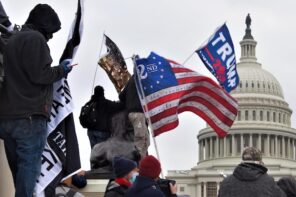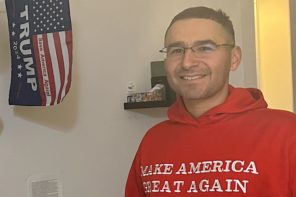Last week, the Biden administration published the first-ever National Strategy for Countering Domestic Terrorism. With an initial summary released in March of 2021, the full report is in response to the January 6th insurrection and the subsequent order by President Biden for intelligence and law enforcement agencies to comprehensively assess the scope of domestic terrorism in the United States in 100 days. The result is a four-pillared strategy to tackle the “most lethal” terrorist threat today, which is defined as “extremists who advocate for the superiority of the white race and anti-government or anti-authority violent extremists.” These pillars are: (1) a nationwide information network; (2) prevention of recruitment and mobilization; (3) disruption and deterrence of domestic terrorism activity; and (4) confronting long-term contributors to domestic terrorism.
It is commendable, if anticlimactic, that a President of the United States is recognizing, reporting, and calling for the assessment of white nationalist terrorism in the United States, particularly in the wake of the January 6th insurrection. It’s likely that the former president’s base, many of whom shared the concerns and beliefs of those being targeted by this strategy, would have taken exception to such an effort. However, this Strategy glaringly omits the current inequities of the national security paradigm by failing to redress the surveillance and criminalization of Black and brown Americans, particularly Muslims, and by reinforcing measures to counter terrorism through law enforcement, which will only reify the disparities within law enforcement that disproportionately target Black and brown Americans.
Pillar One is to “understand and share domestic terrorism-related information” through the following strategic goals: to enhance research and analysis, to improve information sharing across the federal government and beyond, and to highlight the transnational aspect of terrorism. Certainly, white nationalist terrorism is transnational. The designations between domestic and foreign terrorist groups as defined by the PATRIOT Act are no longer relevant, if they ever were, in a world hyper-connected through social media and technologies. The Strategy withholds the right to designate white nationalist organizations as Foreign Terrorist Organizations (FTOs) or Specially Designated Terrorists. Notably, it does not reorient the current parameters of these labels.
At present, the majority of groups and people determined by the State Department to fall under these labels are militant Islamist groups like al-Qa’ida and al-Shabaab and individuals. It does not apply to those who uphold the ideology of white nationalism, or the pursuit of a white ethno-state because of the belief in the cultural, biological, and/or divine superiority of the white race. In practice, the failure to reorient the current counterterrorism strategy developed in the wake of 9/11 to address the full scope of the terrorist threat post-1/6 undermines its efficacy.
Pillar Two “prevents domestic terrorism recruitment and mobilization to violence” through addressing terrorist content online with technology companies and civil society organizations, reducing access to assault weapons and high-capacity magazines, and focusing on Ghost Skins, or members of the military who are affiliated with and recruited by white nationalist groups because of their tactical know-how.
Pillars One and Two overlap in that they both focus on information-sharing internally and externally of the federal government “that can be identified from open-source information.” The offline and online surveillance of Black and brown communities continues unabated despite the Strategy’s declaration that it respects the “foundational constitutional protection for free speech and association.” Indeed, the history of surveillance in the United States beginning with the establishment of the FBI in 1908 is the chronicle of infringing upon civil liberties and freedom of speech in order to target individuals and communities deemed to be politically subversive, including (perceived) communists, civil rights leaders, and communities of color.
This is not to say that white nationalists have not faced the same tactics of surveillance. From 1991 to 1993, the FBI surveilled white nationalists, including Civilian Materiel Assistance, the Texas Light Infantry, and the American Pistol and Rifle Association, in an operation called PATCON, short for Patriot Conspiracy. Unlike the COINTELPRO operation that ran from 1956 to 1971 and the systemic surveillance of Muslim Americans after 9/11 PATCON neither resulted in prosecutions nor in the criminalization of white Americans, nor in the suspicion of white people everywhere.
On the other hand, the political groups and the Black and brown Americans that were targeted by security agencies by organized surveillance through Joint Terrorism Task Forces, for example, are viewed as un-American, under constant suspicion of violence by law enforcement and fellow citizens alike.
The Strategy released by the Biden administration only makes these disparities distinct rather than ameliorating the underlying inequities. For example, when discussing the dissemination of harmful content by “malicious actors online,” the Strategy cites al-Qa’ida instead of the Oath Keepers, Proud Boys, and other white nationalist groups and individuals who purposefully planned the January 6th attack on the US Capitol. Currently, the Strategy replicates the post-9/11 security paradigm without eliminating the inequities thereby undercutting its ability to address the reality of white nationalist terrorism.
Pillar Three seeks to “disrupt and deter domestic terrorism activity” through enhanced investigations, assessing potential legislative reforms to prosecute domestic terrorism “to the fullest extent of the law,” and background checks for government employees. As the disparate treatment of white Americans and Americans of color within the carceral system has repeatedly evidenced, investigations and prosecutions will disproportionately criminalize Black and brown Americans—but especially Black Americans.
Despite the Strategy stating white nationalism is the most pressing threat to the United States and that it seeks to counter this threat, it fails to safeguard Americans of color from the reality of biased profiling by law enforcement and technology. Furthermore, the counterterrorism model based on prevention and pre-emptively identifying threats that have been utilized by the US and the UK have only infringed upon free expression and civil liberties. Any legislation that seeks to advance a federal criminal statute for domestic terrorism will similarly be exploited and leveraged to harm minoritized communities in the United States.
Pillar Four aims to “confront long-term contributors to domestic terrorism” by “tackling racism in America” and “protecting Americans from gun violence and mass murders” as well as providing care for “those who pose a danger to themselves or others” and “ensuring that Americans receive the type of civics education that promotes tolerance and respect for all.” In short, a rehaul of the education, carceral, public health, and military systems of the United States, which is what my own concept of holistic justice calls for in my book, Homegrown Hate.
Unlike my framework for advancing a new counterterrorism paradigm, this Strategy does not take into account the need to redress the inequities borne from the post-9/11 worldview in order to productively tackle the reality of post-1/6 America—a nation divided at its core along the lines of identity, reality, and truth. For instance, ensuring “that law enforcement operates without bias” is a worthy sentiment, but in practice as the vast disparities between police approach of Black Lives Matter advocates and the mainly white insurrectionists on January 6th have made evident, bias within law enforcement is a systemic issue. So, too, is white nationalism within the military, which this Strategy similarly seeks to address. Again, conspicuously absent from the Strategy is any mention of ridding the security apparatus of Fusion Centers, which have surveilled and criminalized Americans since 9/11 and operate with scant oversight.
Effective counterterrorism policies must disengage from a law enforcement perspective and center education, public health, housing, and the media to redress the interlocking systemic inequities along the axis of racism that have allowed the criminalization, suspicion, and continued institutionalized oppression of Black and brown Americans. Ultimately, while the Biden administration’s Strategy seeks to address white nationalist terrorism, it fails to protect Americans of color from white nationalist violence.





